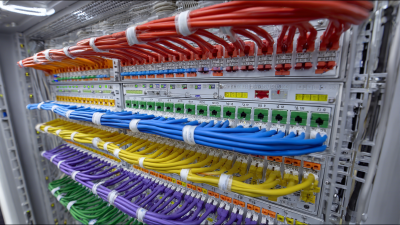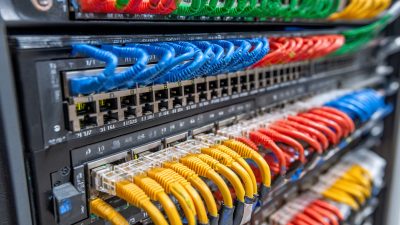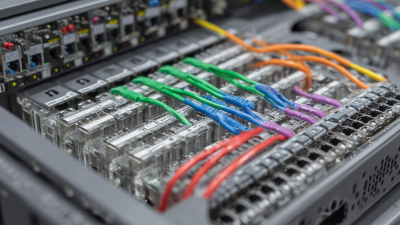What is Networking Solutions? Understanding Key Concepts and Benefits for Your Business
In today's fast-paced digital landscape, the significance of networking solutions cannot be overstated. As businesses increasingly rely on connected technologies, the implementation of effective networking strategies has become vital for ensuring operational efficiency and competitiveness. According to a recent Gartner report, organizations that invest in comprehensive networking solutions can expect to reduce operational costs by up to 30% while increasing productivity by over 20%. This highlights the crucial role that networking plays in modern business infrastructures.

Networking solutions encompass a variety of technologies and processes designed to facilitate seamless communication and data exchange among devices and users. As per a study by the International Data Corporation (IDC), the global market for networking solutions is projected to reach $100 billion by 2025, driven by the growing demand for enhanced security, scalability, and remote connectivity. Businesses that embrace these solutions are not only better equipped to handle existing challenges but also gain a competitive edge in an evolving marketplace.
Understanding the key concepts and benefits of networking solutions is essential for any business looking to thrive in the digital era. As we explore the intricacies of these solutions, we will uncover how they can transform operations, improve collaboration, and ultimately drive growth and innovation within organizations, paving the way for a more connected and efficient future.
Understanding the Basics of Networking Solutions and Their Importance for Businesses
Networking solutions are essential for businesses of all sizes, providing the infrastructure that enables communication, data exchange, and collaboration. At its core, networking involves the interconnection of devices—such as computers, servers, and printers—allowing them to share resources and information efficiently. Understanding the basics of networking solutions is crucial for business owners and IT managers since a well-implemented network can enhance productivity, streamline operations, and support growth.

Moreover, networking solutions offer significant benefits, such as improved security and greater flexibility. With the rise of remote work and cloud computing, companies need a reliable network to ensure their data remains safe and accessible. By employing various networking technologies, businesses can create secure connections that protect sensitive information from unauthorized access.
Additionally, scalable networking solutions allow companies to adapt to changing market demands, ensuring that as they grow, their network can accommodate new users and devices without compromising performance.
Key Components of Networking Solutions: Routers, Switches, and Firewalls Explained
Networking solutions are essential for businesses seeking to establish efficient communication and data exchange. Key components of these solutions include routers, switches, and firewalls. Each plays a crucial role in ensuring network reliability and security.
Routers are devices that direct data traffic between different networks, making it possible for multiple devices to communicate effectively. They assign IP addresses, manage traffic flow, and can even provide wireless connectivity. Switches, on the other hand, are responsible for connecting devices within a single network, enabling them to share information seamlessly. Unlike routers, which connect different networks, switches enhance communication among local devices by creating a network's internal pathways.
Firewalls protect the network by monitoring and controlling incoming and outgoing traffic based on predetermined security rules. They act as a barrier between trusted internal networks and untrusted external networks, ensuring that sensitive data remains secure. By implementing these three components, businesses can create a robust networking solution that supports their operational needs while protecting against potential threats.
Measuring the ROI of Networking Solutions: Industry Statistics and Case Studies
The return on investment (ROI) of networking solutions is a critical metric for businesses aiming to evaluate the efficacy of their technological investments. Industry statistics indicate that organizations implementing robust networking solutions can achieve substantial cost savings, with reports suggesting that productivity can increase by as much as 30%. This uptick often results from improved communication and collaboration among teams, facilitated by more efficient networking infrastructures tailored to their specific needs.

Case studies further illustrate the tangible benefits of networking solutions. For instance, a mid-sized manufacturing company that invested in a comprehensive networking platform reported a 25% reduction in downtime and a significant improvement in supply chain efficiency. By leveraging real-time data and streamlined communication channels, the company was able to enhance operational performance while also improving customer satisfaction. Such examples underscore the importance of assessing ROI in networking solutions, as organizations continue to seek ways to not only enhance productivity but also drive overall business growth.
Enhancing Business Productivity through Effective Networking Solutions Strategies
In today’s fast-paced business environment, effective networking solutions are essential for enhancing productivity. According to a report by Gartner, organizations that leverage integrated networking solutions can boost their operational efficiency by up to 30%. This is primarily achieved through streamlined communication processes and improved access to information. By adopting tailored networking strategies, businesses can create a collaborative environment that fosters innovation and increases overall performance.
To maximize the benefits of networking solutions, companies should focus on a few key strategies. First, invest in robust infrastructure that supports seamless connectivity across all departments. Research from Forrester indicates that organizations prioritizing advanced networking technologies experience 25% higher employee satisfaction rates. Second, regular training programs can ensure that all team members effectively utilize these networking tools, thereby minimizing friction and enhancing workflow.
**Tips:** Implementing a clear communication protocol can significantly improve team collaboration. Additionally, utilizing cloud-based networking solutions can facilitate remote access, allowing employees to maintain productivity regardless of their location. Regularly assessing the efficacy of your networking solutions can also help identify areas for improvement, ensuring that your business remains competitive in a rapidly evolving landscape.
Impact of Networking Solutions on Business Productivity
Future Trends in Networking Solutions: What Businesses Need to Know for 2024 and Beyond
The networking solutions landscape is undergoing significant transformation as businesses prepare for the future. In 2024, the global AI market is projected to be valued at $23.46 billion, with expectations to surge to $177.17 billion by 2032, reflecting a robust compound annual growth rate. This rapid growth underscores the increasing reliance of businesses on intelligent applications and networking innovations to drive operational efficiency and strategic insights.
As we look toward 2024 and beyond, companies must adapt to emerging trends within networking solutions. The rise of generative AI as a strategic engine for business transformation is noteworthy, as it enhances the scalability and security of networking infrastructures. Additionally, the transition to “as-a-service” models, particularly in secure SD-WAN deployments, is set to reshape how organizations approach network security and connectivity, ensuring they remain resilient in a rapidly evolving digital landscape. Embracing these trends will be crucial for businesses aiming to leverage technology for competitive advantage.
What is Networking Solutions? Understanding Key Concepts and Benefits for Your Business - Future Trends in Networking Solutions: What Businesses Need to Know for 2024 and Beyond
| Dimension | Description | Current Trends (2024) | Potential Benefits |
|---|---|---|---|
| Network Security | Protection of network data and resources from unauthorized access or attacks. | Increased use of AI for threat detection and response. | Enhanced data protection and reduced risk of breaches. |
| Cloud Networking | Utilizing cloud technology for networking infrastructure and services. | Growing adoption of hybrid cloud solutions. | Scalability and flexibility in managing network resources. |
| SD-WAN | Using software to manage wide area network connections and traffic. | Increased focus on optimizing bandwidth and improving application performance. | Cost efficiency and improved user experience. |
| Internet of Things (IoT) | Network of physical devices connected to the internet for data exchange. | Rising number of IoT devices and applications across sectors. | Improved operational efficiency and new business opportunities. |
| AI and Machine Learning | Implementing AI tools for network management and optimization. | Increase in automated solutions for network monitoring. | Reduced manual workload and enhanced decision-making. |
Related Posts
-

7 Best Practices for Selecting the Right Patch Panel for Your Network
-

Maximize Your Network Efficiency: Understanding the Role of Cat 6 Patch Panels in Modern Data Centers
-

Understanding the Importance of Fiber Optic Patch Cord in Modern Networking Solutions
-

7 Best Patch Cable Options for Seamless Connectivity Solutions in 2023
-

5 Best LC Patch Panels for Optimal Network Performance in 2023
-

How to Choose the Right Patch Panel for Your Networking Needs
